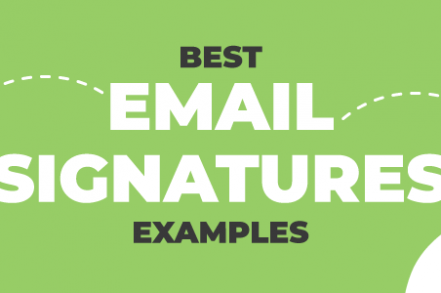Whether you’re conducting a mass email marketing campaign, or you’re using your email account for everyday communications, your signature matters. The way you sign off your email will have an impact on how your recipients will remember you.
The Importance of an Email Signature
The importance of the email signature is often overlooked. It’s not simply a way of signing off your email, and it’s more than a statement of how your recipients can get in touch with you.
Your email signature is an opportunity.
Firstly, it’s an opportunity to say something about who you are: as a person, as a professional, and as a company. Your colors, font, and design will demonstrate your brand values, tying in with every other aspect of your visual media.
Secondly, it’s an opportunity to connect with your recipients. Whether it’s to invite them to join you on social media, encourage them to visit your website, even urge them to download your latest podcast, your signature can support some of your broader sales and marketing goals.
15 Best Email Signature Examples
1. Include a headshot
Your email signature will usually include your basic contact information, but a warm photo of yourself will bring your signature to life and add a personal touch to your email. Top tip: Make sure you smile!
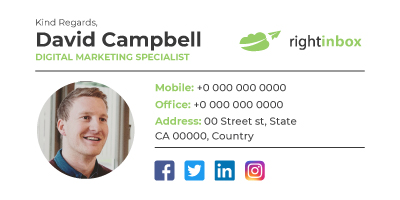
2. Include a visual
By the same token, an animated GIF is a good way to bring your signature to life. Some GIFs can be enough to send anyone straight to the website to place an order.
3. Link to a YouTube video
Video content is said to be one of the most successful channels for nurturing leads.
If you have a big presence on YouTube, then showcase your videos in your signature – you could even earn some new subscribers.

4. Showcase a product
If you’re an ecommerce business hosted on an enterprise eCommerce platform, use your signature to convert your recipients into customers. Showcase your latest product by providing a visual, a description, and a link to the product page.

5. Showcase your portfolio
If you’re a visual business such as a photographer or graphic designer, your signature can showcase your most recent or most popular work. Even better, ensure each image links through to a relevant page on your website.
Do you need more than one email signature? If so than Right Inbox email signature feature is a must. Try for free
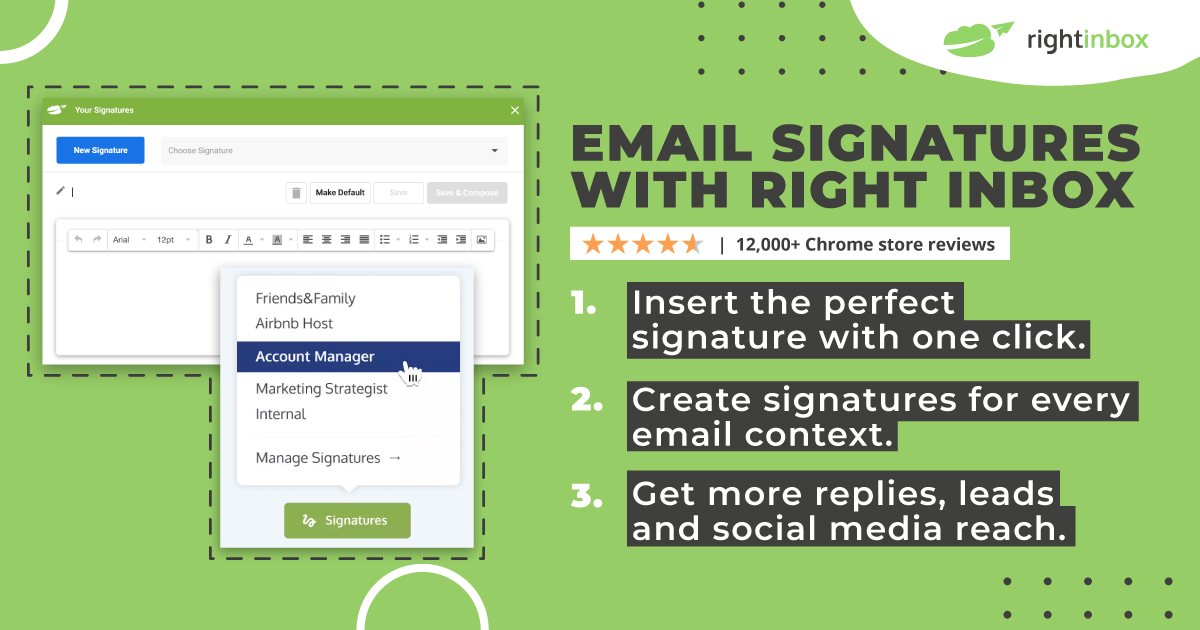
6. Link to your social profiles
It’s standard practice to grow your social following by linking to your profiles in your email signature. Make sure you use attractive icons that link directly through to your profile.

7. Ask for a Review
Recieving a good review is one of the top authority signals to Google (as well as potential customers). Why not use your signature to ask for a review? Just make sure you make it easy for your customers to leave one by linking through to the relevant review site.
8. Keep it simple
While it’s tempting to use your email signature to provide your recipients with as much detail as possible, there’s a lot to be said for keeping it simple.
If you provide too many calls-to-action and links, you risk confusing your recipients. They’re far more likely to convert if they see just a simple link and a couple of social icons:

9. Include a Link to Google Maps
It’s up to you whether or not you include a physical address in your email signature; it might even be a legal requirement that you include one. However, if it makes sense for you to include one – say your business is a restaurant or shop – then it’s worth considering inserting a link to your location on Google Maps.
A link to Google Maps will allow your recipients to click straight through from your email to Maps when they read your email on their smartphone. Great news if they need to locate you when they’re on the go!

10. Use Color
When you’re planning the design of your email signature, it’s worth remembering that color catches attention. A burst of color may be all that’s needed to get you noticed and remembered by your recipients.
That said, you can go wrong by using too many colors, or color combinations that make you look over-the-top or childish. So, our advice is to use color with caution:
- Choose one or two complementary colors.
- Choose colors that match your industry – for example, brighter colors may suit creative agencies, whereas professional services might want to opt for a subtler palette.
- Ensure that your colors are in line with the rest of your branded material.
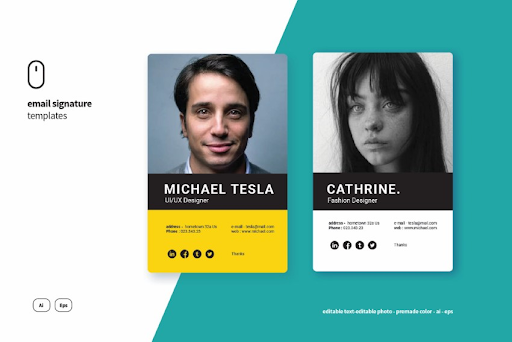
11. Make it Responsive to Mobile
It’s more than likely that your recipients will be reading your email on their smartphone instead of – or as well as – their desktop or laptop. It’s crucial that you create your signature with mobile in mind.
- Use logos that translate well onto smaller screens.
- Make sure text appears in the right format when read on a mobile.
- Ensure that links and icons are spaced properly so they can be tapped.

12. Use a Hand-Written Sign-Off
A hand-written sign-off can add a personal touch to your email signature. And although you recipients will know that you haven’t personally penned your email, the handwritten signature, like the one below, will give them that illusion.
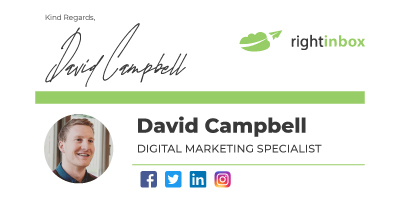
13. Include a call-to-action
You are not limited to using your email signature as a means to get a review.
You can also nudge your recipient to take a specific action by adding a suitable call-to-action (CTA) that is polite, assertive, and feels more like a postscript than a sales pitch.
Just make sure that your CTA contains a single, clear message that is easy to understand and follow.

14. Don’t forget to add data privacy and legal disclaimers
For some industries, there can be certain legal disclaimers that you’re bound to display in your email. And email signatures provide a good way of doing this.
Here are some common disclaimers that are often mentioned in email signatures:
- Confidentiality disclaimer
- Virus transmission disclaimer
- Non-binding disclaimer
- Personal opinion disclaimer
- The General Data Protection Regulation (GDPR) disclaimers

15. Use space dividers
You want to make your email signature as comprehensive as possible, but you don’t want it to look overcrowded, disorganized, and ugly. And space dividers are a good way of keeping your signature clean.
They allow you to separate different pieces of information with spaces and present them in a nice and tidy way. You can also use a glyph divider (i.e. the vertical sign “|”) to separate your logo, giving a more pleasant look to your email signature.

Most Important Elements of an Email Signature
Your name, title, and company
Include your name and the name of your company you’re representing.
Contact information
Include your company website, at least one phone number, but avoid the unnecessary step of including an email address.
Job title or department (optional)
You might find it useful to let people know your exact job title or which department you work in, but it’s not necessary to include both.
Company physical address (or Google Maps link)
Ideally use a Google Maps link rather than take up valuable space with a mailing address.
A disclaimer or other legal requirements
There may be some legal requirements you need to meet in your email signature, so it’s worth checking with a lawyer to get this right.
A CTA (optional)
If you have a sales or marketing goal you’re working towards, your email signature could be a great place to recruit an audience.
Social icons
If your social profiles are well-managed and up-to-date, include social icons in your Gmail signature to encourage people to connect with you.
Responsive design
With 70% of people reading their emails via a smartphone app, make sure your signature works for mobile.
A logo or headshot (optional)
A headshot can help your recipients put a face to your name. A company logo (that clicks through to the website) can help to raise brand awareness and drive traffic.
Email Signature Frequently Asked Questions (FAQs):
How many lines should an email signature be?
Professional email signatures look best when they are kept simple and short. That’s why you should try and limit your signature to 3 to 4 lines of text, mentioning only the essentials like full name, job title, and contact information.
Should I bold my name in my email signature?
Yes, it’s a good idea to bold text in your signature. It helps you highlight important details — such as yourname, position, and company — within your email signature by naturally drawing the recipient’s attention to the bolded text. Similarly, you can also try italicizing certain texts to lay emphasis on them.
What color should my email signature be?
Calm and elegant colors, such as blue and black, are the most recommended colors for email signatures. But you can choose any color that best communicates your mood, the company’s mission, and the necessary call to action as long as it’s not too flashy.
Should I include a disclaimer or legal notice in my email signature?
Including a disclaimer or legal notice in your email signature depends on your companies policies. Some industries or professions may require specific disclaimers for legal or regulatory purposes.
Should I include my full contact details in the email signature?
Including your full contact details is not necessary. Providing your name, email address, and phone number is usually sufficient.
What not to include in my email signature?
Your email signature should not contain any unnecessary piece of information that would clutter it up. This may include:
- Religious/political statements
- Inspirational quotes
- Links to unused social accounts
- Too much contact information
- Pointless certifications
- Large image files
- Multiple and flashy color fonts
Your email signature is a prime opportunity to convert your recipients into social followers, customers, and loyal fans. The key is to find the right combination of visuals, information, and calls-to-action to provide your recipients with options without overwhelming them.
Track emails, email reminders & templates in Gmail for free
Upgrade Gmail with the features it’s missing
Add to GmailDavid Campbell
David Campbell is the editor of the Right Inbox blog. He is passionate about email productivity and getting more done in less time.
